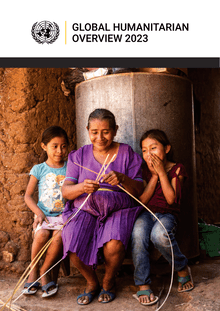Global trends
After 20 years, forced displacement shows no sign of slowing. More than 1 per cent of the world’s population — or 103 million people — are displaced. About two thirds of refugees and asylum-seekers originate from countries with food crises, and nearly a quarter of all refugees are hosted in Least Developed Countries. Disasters and extreme weather events, such as flooding and drought, are responsible for the majority of forced displacements worldwide.
Violent conflict continues to take a heavy toll on civilians, especially when explosives are used in populated areas. Children remain especially vulnerable, and the number of attacks on schools and hospitals has increased. Violence against aid workers is increasing, and 98 per cent of those killed were working in their own country.
The largest global food crisis in modern history is unfolding, driven by conflict, climate shocks and the looming threat of global recession. Hundreds of millions of people are at risk of worsening hunger. Acute food insecurity is escalating, and by the end of 2022, at least 222 million people across 53 countries are expected to face acute food insecurity and need urgent assistance. Starvation is a very real risk for 45 million people in 37 countries.
Climate change is contributing to humanitarian crises worldwide, with climate-related disasters driving increased levels of risks and vulnerability. The past eight years are on track to be the eight warmest on record and 2022 is estimated to be among the hottest. Of the 15 countries most vulnerable to the climate crisis, 12 had an internationally led humanitarian response. By the end of the century, deaths from extreme heat are projected to be comparable in magnitude to all cancers or all infectious diseases.
The global goal of ending extreme poverty by 2030 is no longer achievable, with 90 million more people experiencing this challenging reality than previously projected. Available jobs remain at below pre-pandemic levels, and rising inflation is expected to reach 10 per cent in emerging markets and developing economies. Global fuel and food price hikes are hitting low-income countries the hardest, and most countries with an HRP face lower projected growth in 2023, compounded by challenges of climate change, conflict, rising food and fuel prices, and food insecurity.
Global public health is not improving, as seen in the ongoing COVID-19 pandemic, monkeypox outbreaks, the rapid spread of vector-borne diseases, rising cases of Ebola, and cholera outbreaks. Only 2.3 per cent of the 13 billion COVID-19 vaccines administered worldwide took place in the 29 countries with an HRP. Infant vaccine coverage has seen the largest recorded reduction in 30 years, and critical testing, treatment and prevention activities for infectious diseases and HIV have declined.
It will now take four generations – or 132 years – to achieve global gender parity. Globally, 388 million women and girls live in extreme poverty, more than men and boys, with the vast majority in sub-Saharan Africa and Central and Southern Asia. The pandemic has increased the risks of gender-based violence (GBV) worldwide, and 13 million more girls are assessed to be at risk of becoming child brides in addition to the 100 million already at risk.
Global education is in crisis due to the pandemic’s ongoing impacts. Schoolchildren in middle-income countries endured significantly longer school closures than those in high-income countries. The digital divide persists: of the 1.6 billion students out of school, 1.3 billion had no Internet connection at home or a device to learn on — a situation that is even more acute for those students living in humanitarian crises.
Explore the full report and interactive content through humanitarianaction.info
Published in GI-Mail 02/2023 (English edition).
- Do you already know our monthly newsletter GI-Mail with useful tips on postgraduate courses?
Sign up here. - Are you looking for vacancies or new career challenges? Here you will find the latest vacancies and job offers.
- Do you already know our monthly job-information GI-Jobs with current job offers for doctors, managers and nurses? Sign up here.
- Are you interested in up to date postgraduate courses and CME? In our education database »medicine & health« you will find new education events from over 2300 organizers.

